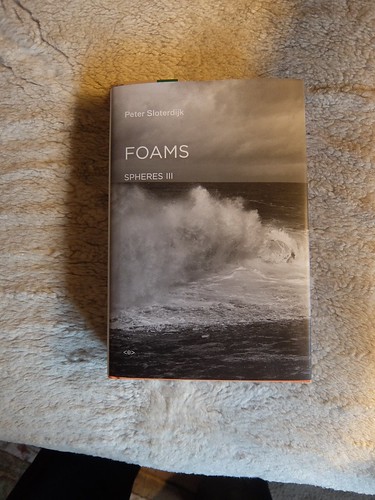I've started with the third book in the trilogy, Foams, which author Peter Sloterdijk says in the introduction is OK.
I'm fortunate to live near a true scholar, Glenn Stockton. He now owns all three in their English translations: Bubbles, Globes and Foams.
I've been blessed with friends who were also serious scholars in my life, Alex another (we had Szechuan food the other day, at John's Landing), and of course Lindsey, and my mom. At Princeton, my contemporary Brian Karafin opened many doors for me.
Whereas Sloterjijk is generously inclusive of Bucky Fuller in his index, I'm not yet sure how much he makes of Synergetics as providing a toolbox of spherical metaphors, right down to the dyadic relationship of self-other and the kinds of twoness one finds in generalized concepts.
The arc of Peter's work starts with the household and village as the archetypal human collective and therefore psychological seed bed for much of our thinking. Here is the micro-sphere or "bubble" of micro-economics, the "hearth".
Surrounding the village was its cosmos, the biggest containing sphere or context, a "globe" with mediation between micro and macro spheres perhaps through a castle (a residence for temporal powers) or a church and its priests (eternity based).
The cosmos was ontologically spherical and provided a celestial cast, of angels, demons, beings beyond human. The microcosm was contained within the macrocosm. Both architecture and alchemy sought to harmonize these relationships.
Any sense of shared consensus sustaining the aforementioned Old World Order, which Peter anchors in European history, has since broken down. The old cosmologies have burst asunder and we experience ourselves in diaspora, more like a foam, with no parent globe to console or contextualize.
However, in his recent writings about orbiting space stations as likewise consciousness-altering, not just for their denizens, the metaphor of Spaceship Earth seems not far beneath the surface. That's a globe, a promised land, we might still agree on. He cites McLuhan a lot, tracing the latter's possible indebtedness to Toynbee for some of his ideas. But does he fully appreciate Fuller?
The "kinds of twoness" to which I referred, as "in pure concepts", would be:
In Foams, Sloterdijk devotes a lot of attention to gas warfare, and also psychological warfare (atmospherics) and manipulation through propaganda. Warfare turned from attacking combatants to undermining their environments. The modern awareness of "climate change" owes a lot to the science of killing and/or "neutralizing" ourselves in large numbers.
I'm fortunate to live near a true scholar, Glenn Stockton. He now owns all three in their English translations: Bubbles, Globes and Foams.
I've been blessed with friends who were also serious scholars in my life, Alex another (we had Szechuan food the other day, at John's Landing), and of course Lindsey, and my mom. At Princeton, my contemporary Brian Karafin opened many doors for me.
Whereas Sloterjijk is generously inclusive of Bucky Fuller in his index, I'm not yet sure how much he makes of Synergetics as providing a toolbox of spherical metaphors, right down to the dyadic relationship of self-other and the kinds of twoness one finds in generalized concepts.
The arc of Peter's work starts with the household and village as the archetypal human collective and therefore psychological seed bed for much of our thinking. Here is the micro-sphere or "bubble" of micro-economics, the "hearth".
Surrounding the village was its cosmos, the biggest containing sphere or context, a "globe" with mediation between micro and macro spheres perhaps through a castle (a residence for temporal powers) or a church and its priests (eternity based).
The cosmos was ontologically spherical and provided a celestial cast, of angels, demons, beings beyond human. The microcosm was contained within the macrocosm. Both architecture and alchemy sought to harmonize these relationships.
Any sense of shared consensus sustaining the aforementioned Old World Order, which Peter anchors in European history, has since broken down. The old cosmologies have burst asunder and we experience ourselves in diaspora, more like a foam, with no parent globe to console or contextualize.
However, in his recent writings about orbiting space stations as likewise consciousness-altering, not just for their denizens, the metaphor of Spaceship Earth seems not far beneath the surface. That's a globe, a promised land, we might still agree on. He cites McLuhan a lot, tracing the latter's possible indebtedness to Toynbee for some of his ideas. But does he fully appreciate Fuller?
The "kinds of twoness" to which I referred, as "in pure concepts", would be:
- the inside-outside dichotomy, the state of being contained, which more negatively is one of being imprisoned, encaged, fenced in (the "buckyball" of 60 carbon atoms is likewise a "carbon cage" analogous to the "carbon- or nano-tubes" of the same graphene substrate).
- the twoness of polarity and axial rotation: the globe spins, the record plays, great circles and hemispheres are formed.
In Foams, Sloterdijk devotes a lot of attention to gas warfare, and also psychological warfare (atmospherics) and manipulation through propaganda. Warfare turned from attacking combatants to undermining their environments. The modern awareness of "climate change" owes a lot to the science of killing and/or "neutralizing" ourselves in large numbers.


